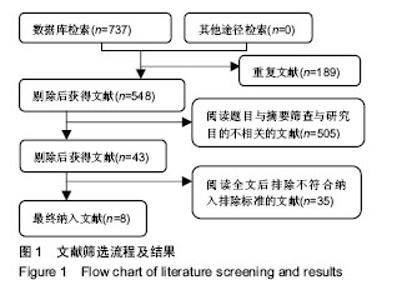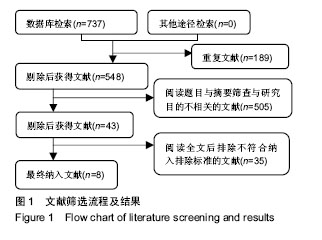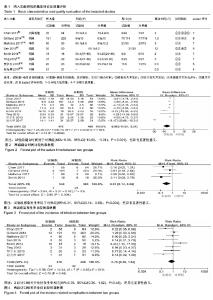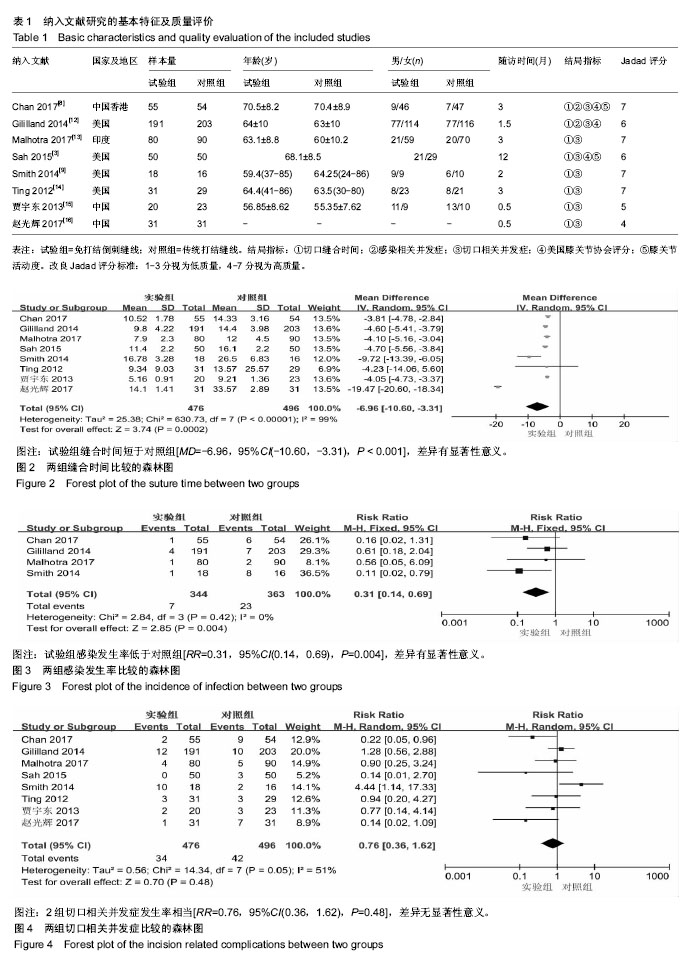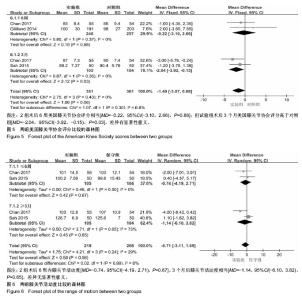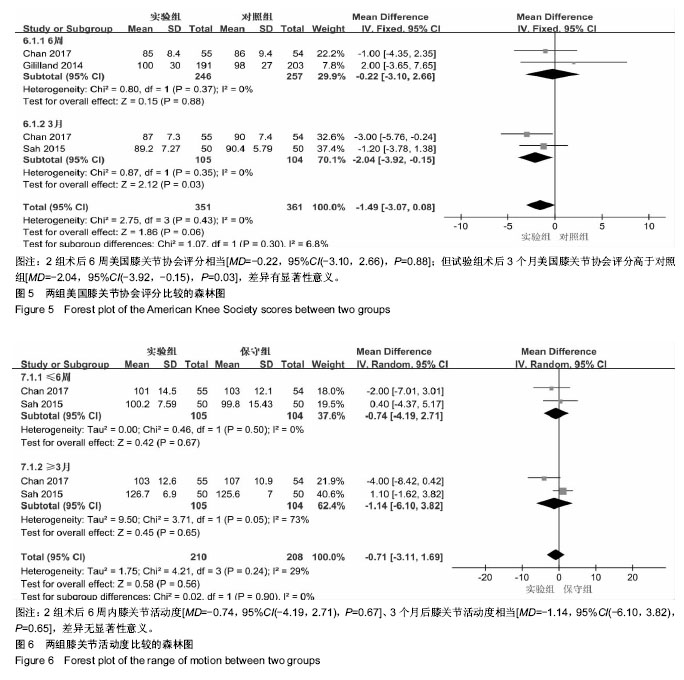| [1] 王世和. 人工膝关节置换:技术发展与临床应用及评价[J]. 中国组织工程研究, 2010,14(35):6587-6590.[2] Kurtz SM, Ong KL, Lau E, et al. Impact of the economic downturn on total joint replacement demand in the united states: Updated projections to 2021. J Bone Joint Surg Am. 2016;96(8):624-630.[3] Sah AP. Is there an advantage to knotless barbed suture in tka wound closure? A randomized trial in simultaneous bilateral tkas. Clin Orthop Relat Res. 2015;473(6):2019.[4] Mckenzie AR. An experimental multiple barbed suture for the long flexor tendons of the palm and fingers. Preliminary report. J Bone Joint Surg. 1967;49(3):440-447.[5] Paul MD. Barbed sutures in aesthetic plastic surgery: Evolution of thought and process. Aesthet Surg J. 2013;33(3 suppl):17S-31S.[6] Villa MT, White LE, Alam M, et al. Barbed sutures: A review of the literature. Psychol Med. 1996;26(5):899-912.[7] Eickmann T, Quane E. Total knee arthroplasty closure with barbed sutures. J Knee Surg. 2010;23(3):163-168.[8] Chan VWK, Chan PK, Chiu KY, et al. Does barbed suture lower cost and improve outcome in total knee arthroplasty? A randomized controlled trial. J Arthroplasty. 2017;32(5): 1474-1477.[9] Smith EL, Disegna ST, Shukla PY, et al. Barbed versus traditional sutures: Closure time, cost, and wound related outcomes in total joint arthroplasty. J Arthroplasty. 2014;29(2): 283-287.[10] Maempel J, Clement N, Brenkel I, et al. Validation of a prediction model that allows direct comparison of the oxford knee score and american knee society clinical rating system . Bone Joint J, 2015,97-B(4):503-509.[11] Jadad A, Moore R, Carroll D, et al. Assessing the quality of reports of randomized clinical trials: Is blinding necessary? Control Clin Trials. 1996;17(1):1-12.[12] Gililland JM, Anderson LA, Barney JK, et al. Barbed versus standard sutures for closure in total knee arthroplasty: A multicenter prospective randomized trial. J Arthroplasty. 2014;29(9):135-138.[13] Malhotra R, Jain V, Kumar V, et al. Evaluation of running knotless barbed suture for capsular closure in primary total knee arthroplasty for osteoarthritis-a prospective randomized study. Int Orthop. 2017;41(10):2061-2066.[14] Ting NT, Moric MM, Valle CJD, et al. Use of knotless suture for closure of total hip and knee arthroplasties : A prospective, randomized clinical trial. J Arthroplasty. 2012;27(10): 1783-1788.[15] 贾宇东,刘又文,赵明媛. Quill可吸收自封缝线在髋关节置换术中的应用[J]. 中医正骨,2013,25(8):7-9.[16] 赵光辉,马建兵,王志远,等. 倒刺缝线在初次全膝关节置换术中的随机对照研究[J]. 实用骨科杂志,2017,23(9):827-829.[17] Alexander T. Wounds and lacerations: Emergency care and closure, 3rd edition. Emerg Med Australasia. 2010;18(4): 412-412.[18] Khan R, Fick DF, Tang K, et al. A comparison of three methods of wound closure following arthroplasty: A prospective, randomised, controlled trial. J Bone Joint Surg. 2006;88(2):238-242.[19] Peersman G, Laskin R, Davis J, et al. Prolonged operative time correlates with increased infection rate after total knee arthroplasty. HSS J. 2006;2(1):70-72.[20] Patel RM, Cayo M, Patel A, et al. Wound complications in joint arthroplasty: Comparing traditional and modern methods of skin closure. Orthopedics. 2012;35(5):e641.[21] 瓦热斯江•尼牙孜,赵巍,米尔阿里木•木尔提扎,等. 双向锯齿缝线在人工全膝关节置换术中的应用[J]. 生物骨科材料与临床研究, 2015,12(2):56-59.[22] Vakil JJ, O'Reilly MP, Sutter EG, et al. Knee arthrotomy repair with a continuous barbed suture: A biomechanical study. J Arthroplasty. 2011;26(5):710-713.[23] Zaruby J, Gingras K, Taylor J, et al. An in vivo comparison of barbed suture devices and conventional monofilament sutures for cosmetic skin closure: Biomechanical wound strength and histology. Aesthet Surg J. 2011;31(2):232.[24] Nett M, Avelar R, Sheehan M, et al. Water-tight knee arthrotomy closure: Comparison of a novel single bidirectional barbed self-retaining running suture versus conventional interrupted sutures. J Knee Surg. 2011;24(1):055-060.[25] Moran ME, Marsh C, Perrotti M. Bidirectional-barbed sutured knotless running anastomosis v classic van velthoven suturing in a model system. J Endourol. 2007;21(21): 1175-1178.[26] 韩文锋,毕岩,赵文,等. Quill缝线在膝关节初次置换中的临床应用[J]. 中国骨与关节损伤杂志, 2014,29(1):71-72.[27] Murtha AP, Kaplan AL, Paglia MJ, et al. Evaluation of a novel technique for wound closure using a barbed suture. Plastic Reconstructive Surg. 2007;120(1):349-350.[28] Gililland JM, Anderson LA, Sun G, et al. Perioperative closure-related complication rates and cost analysis of barbed suture for closure in tka. Clin Orthop Relat Res. 2012;470(1): 125-129.[29] Namba RS, Inacio MC, Paxton EW. Risk factors associated with deep surgical site infections after primary total knee arthroplasty: An analysis of 56 216 knees. J Bone Joint Surg Am. 2013;95(9):775.[30] Shuhaiber H, Chugh T, Burns G. In vitro adherence of bacteria to sutures in cardiac surgery. J Cardiovasc Surg. 1989;30(5): 749-753.[31] 赵恒,殷庆丰,刘文广,等. 新型倒刺缝线在髋膝关节置换深层组织缝合中的应用[J]. 山东大学学报(医学版), 2015,53(8):53-56.[32] Marsh C, Perrotti M, Moran ME. Bidirectional-barbed sutured knotless running anastomosis v classic van velthoven suturing in a model system. J Endourol. 2007;21(21): 1175-1178.[33] Campbell AL, Jr DAP, Liabaud B, et al. Superficial wound closure complications with barbed sutures following knee arthroplasty. J Arthroplasty. 2014;29(5):966-969. |
